| We carried on from Naples across the Tamiami Trail towards Miami.
We paused to look in on a boardwalk which formed an outpost of the
Fakahatchee Strand state park. You need to keep your eyes open, you can't
see much of an alligator in the water. He was even harder to spot when we
came back. | 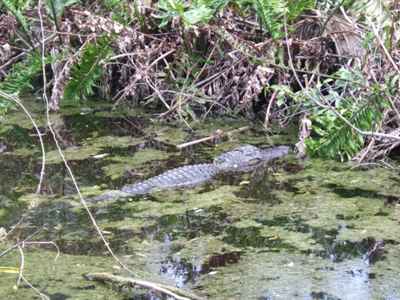 |
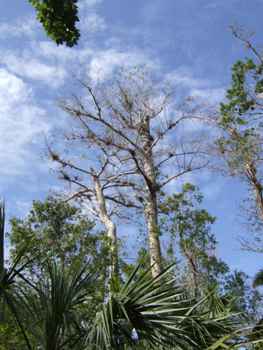 | There was the now
familiar collection of trees ranging from dry pines to wet cypress. Most
notable though was the number of air plants high up in the branches and
looking more like old birds' nests. Some trees were covered in them. |
| This is a royal palm, a species which is now quite scarce in the
wild but which is common in people's gardens. Here they provide excellent
shade to the more fragile plants underneath. But they are prone to losing
their leaves in a hurricane. | 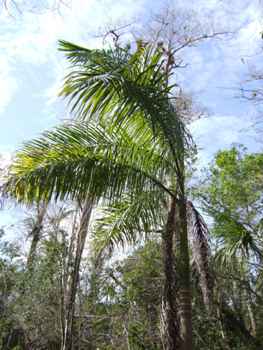 |
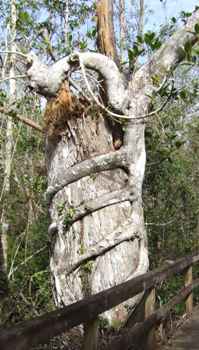 | Another common tree
is the strangler fig. A seed for this lodges on a trunk and as it grows it
sends roots down to the ground. Eventually it strangles the host tree which
dies although continuing to provide support, but it now has its own
well-established root system for survival. It can reach a significant size,
often larger then its original host. |
| Some of the tree barks have deep fissures. These provide a ready
home for the air plants and other bromeliads. These aren't parasites on the
tree but merely use it for support and live on the water and nutrients which
gather in its crevices or the surrounding air. | 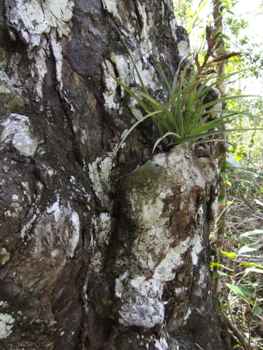 |
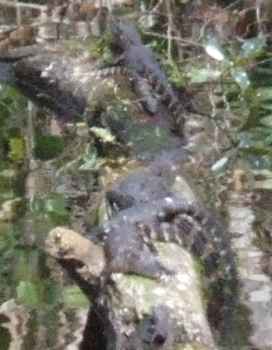 | At the end of the
boardwalk is a small lake/pond with a dead log floating in it. On the log
was a family of baby alligators no more than a foot long. It isn't very
clear but it reminds us of what we could see with the binoculars. |
| A little closer was this Florida turtle with its characteristic
yellow bottom. This one didn't have two heads. | 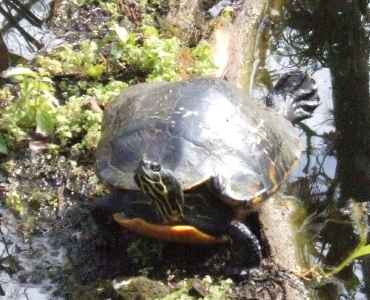 |
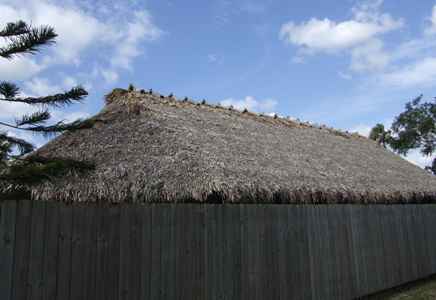 | All along the road
are a number of Miccosukee Indian villages. These have close boarded fences
all round and a number of thatched huts inside. The palmetto thatching was
really all we could see but it all looked in really good condition. They are
an offshoot of the Seminole and Creek tribes who used to inhabit Florida
before it was made an Indian free zone and all the Indians sent to Oklahoma.
A few remained in the Everglades. |
| We moved on along US41 towards the eastern end and stopped in at
the Shark Valley entrance to the Everglades National Park. From here they
run a two hour tram tour down into the Everglades with a ranger telling you
about the birds and the environment. This is home to more alligators which
are everywhere at this time of year (which is the dry season when the water
levels are low so the wildlife congregates near the deeper pools and
creeks). Now they mostly just snooze in the sun at the side of the road.
They can do 30mph so you don't get too close on foot... | 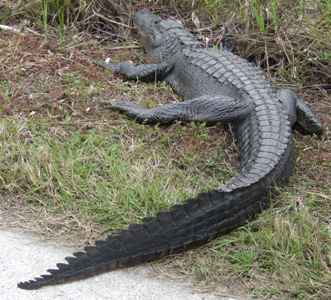 |
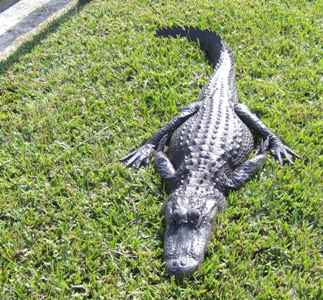 | Mostly they just
seem too exhausted to do anything. Partly at this time of year they are too
cold. But I admire the totally flopped out stance. The grass here is much
coarser than we have at home. I suppose this variety finds it easier to cope
with the feast or famine conditions. |
| Almost every waterway has at least one blue heron. A pair of
nesting wood storks consume 440lb of fish in a season, and I don't suppose
the herons consume much less. It makes you wonder how many fish there are in
there. | 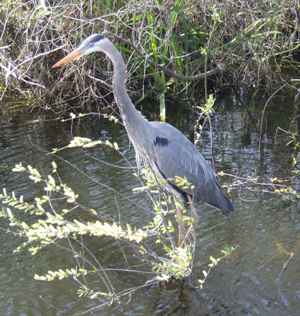 |
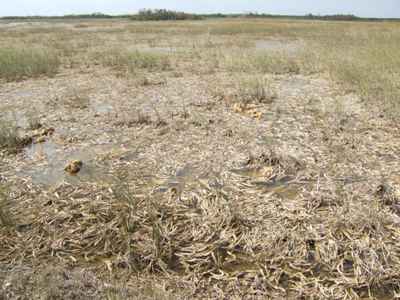 | This is periphyton,
an algae which gathers around the dead grass stalks and forms the bottom of
the food chain for the whole ecosystem. In the dry season it forms a mat
which dries out on top but retains moisture underneath and so preserves the
eggs and tiny creatures for the next season. |
| The water in the Everglades is mostly moving very slowly rather
than stagnant. Think of it as a river 90 miles wide and a few inches deep.
The terrain actually drops 14ft between Lake Okeechobee in the middle of
Florida and the southern coast. Various water management schemes have
affected this flow and impacted the Everglades which once covered over 3
million acres. | 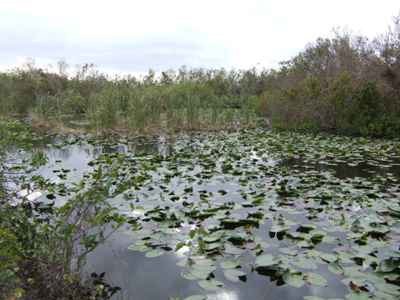 |
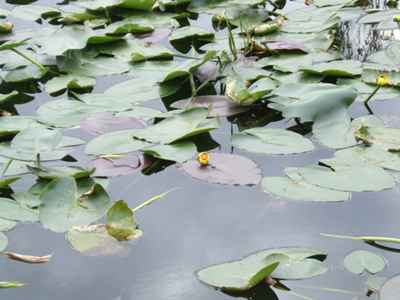 | It all acts as a
huge filtration system. You know the water quality is good when you get this
relative of the water lily. Just a few small yellow flowers at this season,
but I'm sure there are many more later in the year. |
| The tram tour totals 14 miles and this tower is the halfway
point. From the observation platform you can see over 80 miles on a clear
day. Not that there is a lot to see, it is an almost dead flat sea of
predominantly saw grass with isolated hammocks of trees and shrubs where the
land rises a foot or two. And overhead are the constantly circling raptors
looking for a snack. | 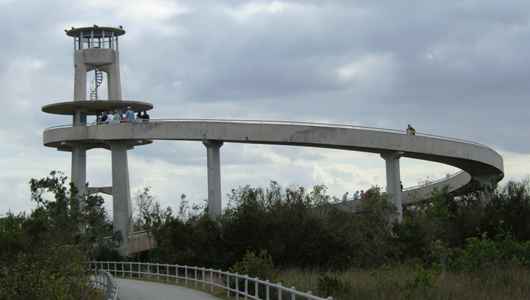 |
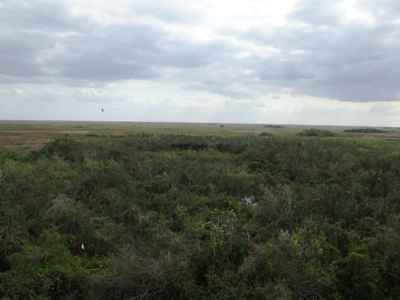 | There are no roads
in this area and it is 50 miles to the sea. Truly a wilderness area and one
of the most fragile environments on the planet. |
| There is quite a variety of birds, most notably the anhinga which
is common all along the Gulf coast in freshwater swamp areas. | 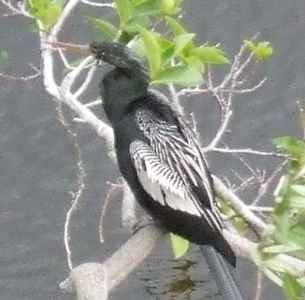 |
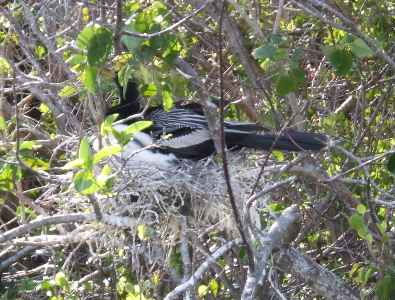 | More difficult is
spotting their nests. Both the males and the females sit on the nest, the
males seem to take the afternoon shift. Perhaps all males appreciate a
snooze in the afternoon. |
| They are fine fishermen and swim about on the water with very
little but their necks showing, and disappear underwater for up to several
minutes. They are mainly black but have beautiful white patterns on their
wings, and webbed feet. This one has a brown neck which means that it is a
female. | 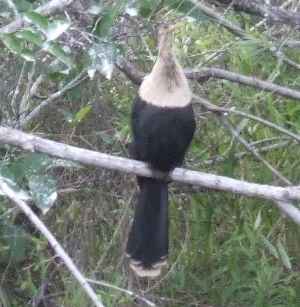 |
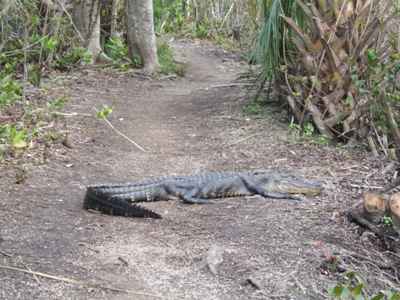 | But the Everglades
are really the home of the alligators, and if one decides to take a snooze
on the path, then that path is closed to humans for the afternoon. |
|